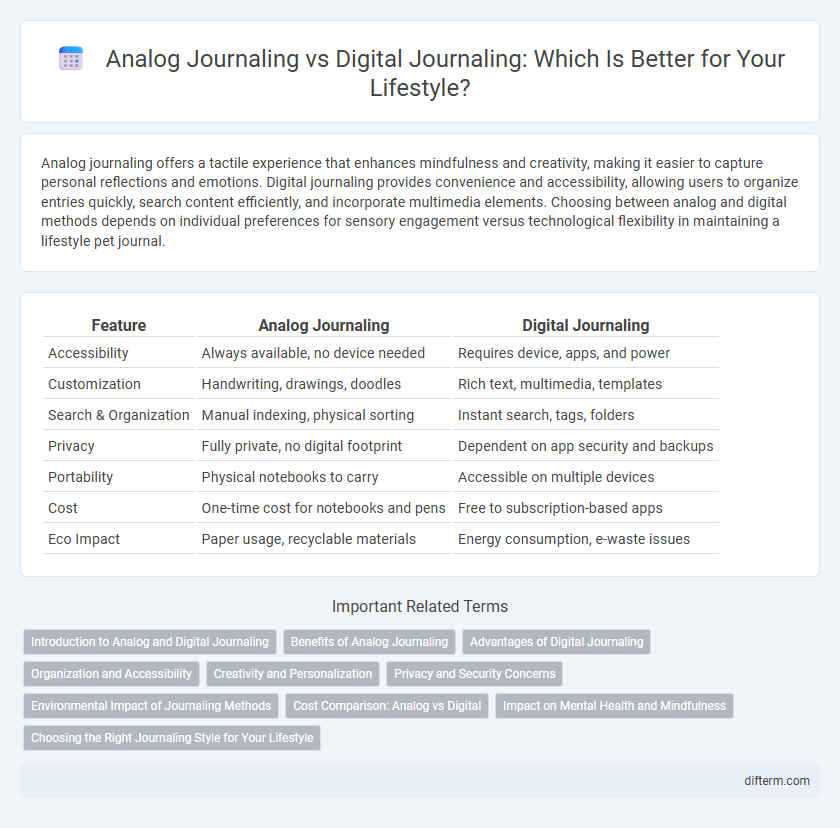Analog journaling offers a tactile experience that enhances mindfulness and creativity, making it easier to capture personal reflections and emotions. Digital journaling provides convenience and accessibility, allowing users to organize entries quickly, search content efficiently, and incorporate multimedia elements. Choosing between analog and digital methods depends on individual preferences for sensory engagement versus technological flexibility in maintaining a lifestyle pet journal.
Table of Comparison
| Feature | Analog Journaling | Digital Journaling |
|---|---|---|
| Accessibility | Always available, no device needed | Requires device, apps, and power |
| Customization | Handwriting, drawings, doodles | Rich text, multimedia, templates |
| Search & Organization | Manual indexing, physical sorting | Instant search, tags, folders |
| Privacy | Fully private, no digital footprint | Dependent on app security and backups |
| Portability | Physical notebooks to carry | Accessible on multiple devices |
| Cost | One-time cost for notebooks and pens | Free to subscription-based apps |
| Eco Impact | Paper usage, recyclable materials | Energy consumption, e-waste issues |
Introduction to Analog and Digital Journaling
Analog journaling involves using physical tools such as notebooks, pens, and paper to record thoughts and daily experiences, offering a tactile and distraction-free environment that enhances mindfulness and memory retention. Digital journaling utilizes electronic devices like smartphones, tablets, or computers, providing features such as cloud synchronization, searchability, multimedia insertion, and customizable templates that streamline organization and accessibility. Both methods serve distinct preferences for creativity and convenience, influencing how individuals capture and reflect on their personal narratives.
Benefits of Analog Journaling
Analog journaling enhances creativity and mindfulness by engaging multiple senses through tactile writing experiences. The absence of digital distractions fosters deeper reflection and emotional processing, making it easier to retain memories and insights. Physical notebooks also provide a personalized, tangible archive that can be revisited without reliance on electronic devices.
Advantages of Digital Journaling
Digital journaling offers unparalleled convenience with instant access across multiple devices, enabling seamless synchronization and effortless organization through tagging and search functions. Enhanced security features such as password protection and cloud backup ensure data privacy and prevent loss. Interactive elements like embedded multimedia and customizable templates enrich the journaling experience, fostering creativity and productivity.
Organization and Accessibility
Analog journaling offers tactile organization through physical notebooks, making it easy to quickly flip through pages and personalize layouts, but it lacks remote accessibility. Digital journaling provides seamless organization with searchable tags, categories, and cloud syncing, allowing users to access notes anytime from multiple devices. However, it requires electronic devices and may present challenges for those who prefer handwritten entries.
Creativity and Personalization
Analog journaling enhances creativity through tactile engagement with paper and pens, allowing unique handwriting styles, doodles, and physical embellishments that digital journaling cannot replicate. Digital journaling offers customizable templates, multimedia integration, and easy editing, enabling users to personalize their entries with images, hyperlinks, and varied formatting options. Both methods support distinct creative expressions, with analog journaling emphasizing sensory experience and digital journaling focusing on versatile, easily modifiable content.
Privacy and Security Concerns
Analog journaling offers enhanced privacy by keeping personal thoughts offline, away from hacking threats and data breaches common in digital platforms. Digital journaling, while convenient and easily searchable, exposes entries to potential vulnerabilities like unauthorized access and cloud storage risks. Choosing analog methods reduces digital footprints and protects sensitive information from cyber threats.
Environmental Impact of Journaling Methods
Analog journaling relies on paper, contributing to deforestation and waste if materials are not sourced sustainably or recycled properly. Digital journaling reduces paper usage but increases energy consumption due to device manufacturing and data storage in servers. Choosing eco-friendly paper and energy-efficient devices can minimize the environmental footprint of both journaling methods.
Cost Comparison: Analog vs Digital
Analog journaling typically involves one-time costs for notebooks and writing instruments, averaging $10 to $50 per year depending on quality and frequency of use, while digital journaling may require investments in apps or devices, ranging from free options to subscriptions costing $5 to $15 monthly. Physical journals offer tactile experience without ongoing fees, whereas digital platforms provide cloud storage and search features but can incur cumulative costs over time. Budget-conscious users often prefer analog journaling for minimal expenses, while tech-savvy individuals may opt for digital journaling to leverage enhanced functionality despite higher long-term costs.
Impact on Mental Health and Mindfulness
Analog journaling enhances mental health by promoting deeper mindfulness through tactile engagement and reduced digital distractions, leading to improved emotional regulation and stress relief. Digital journaling offers convenience and organization, enabling quick access and searchability, but may increase screen fatigue and decrease present-moment awareness. Studies show that the sensory experience of handwriting activates neural pathways linked to memory and cognition, making analog journaling a powerful tool for fostering mindfulness and emotional well-being.
Choosing the Right Journaling Style for Your Lifestyle
Choosing the right journaling style depends on personal habits and daily routines, with analog journaling offering tactile engagement and a distraction-free experience, ideal for those seeking mindfulness and creativity. Digital journaling provides convenience, easy organization, and seamless syncing across devices, making it suitable for busy lifestyles and those who prioritize accessibility. Evaluating factors such as time availability, preferred level of privacy, and the desire for customization can help determine whether analog or digital journaling best enhances your lifestyle.
analog journaling vs digital journaling Infographic

 difterm.com
difterm.com